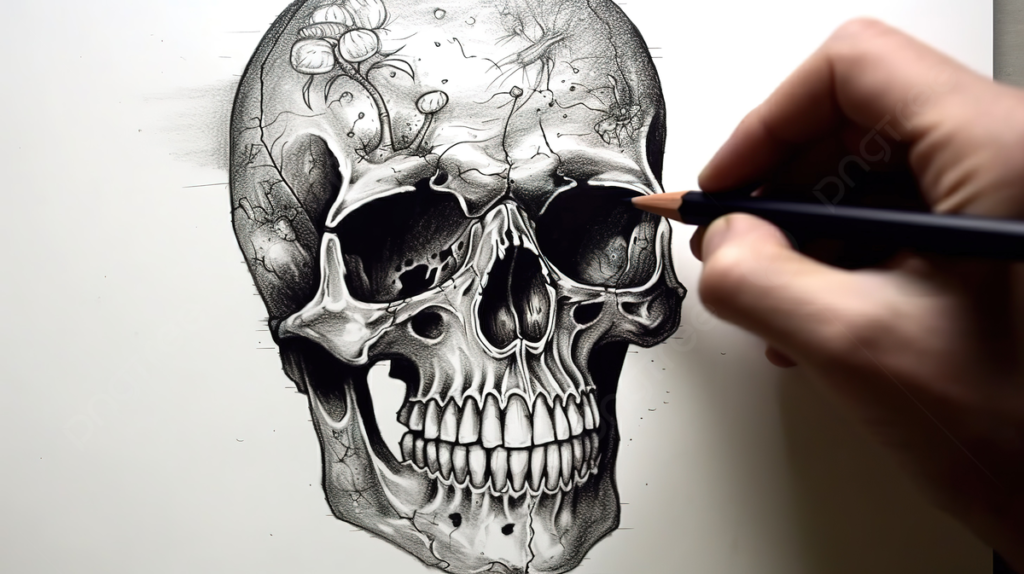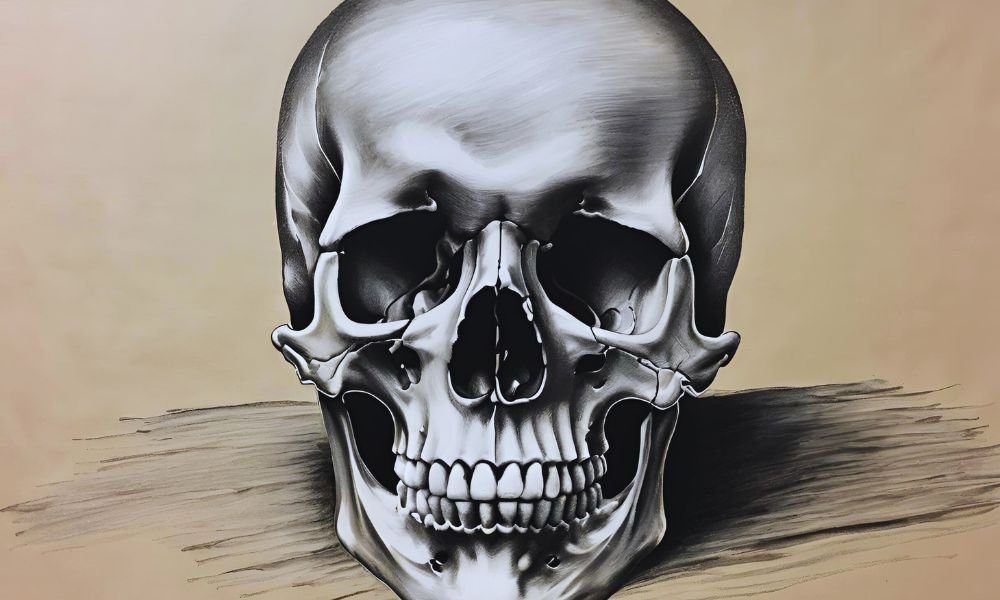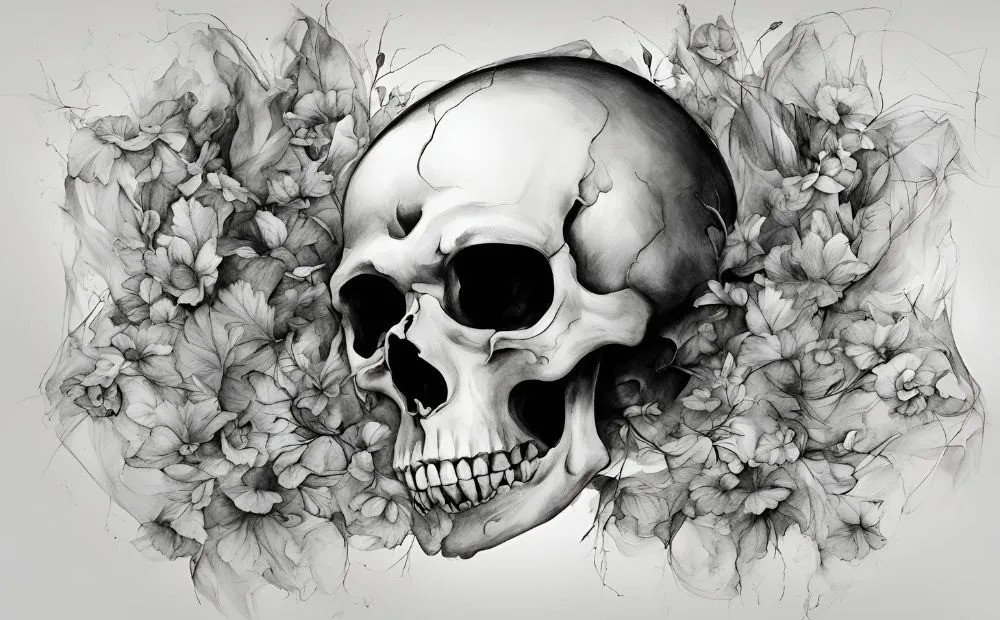Introduction to drawing:oldj_7nsvxk= skull
Drawing the “drawing:oldj_7nsvxk= skull” has become a popular endeavor among artists, historians, and tattoo artists alike. This iconic symbol carries a rich history and offers a plethora of artistic possibilities. Whether you’re an art enthusiast looking to explore new techniques, a history buff intrigued by the symbolism, or a tattoo artist seeking inspiration, this blog post will guide you through the fascinating world of drawing:oldj_7nsvxk= skulls.
In this comprehensive guide, we’ll uncover the historical significance of skulls in art, discuss various styles and techniques for drawing them, and provide practical tips to improve your own “drawing:oldj_7nsvxk= skull” artwork. By the end of this post, you’ll have a deeper appreciation for this timeless symbol and be equipped with the knowledge to create your own masterpiece.
The Historical Significance of Skulls in Art
The use of skulls in art dates back centuries, serving as powerful symbols in various cultures. From ancient civilizations to modern times, skulls have represented everything from mortality and decay to rebirth and transformation. The “drawing:oldj_7nsvxk= skull” is not just an artistic endeavor; it’s a way to connect with history and explore profound themes. Understanding the historical context can add depth and meaning to your artwork.
In ancient cultures, such as the Aztecs and Egyptians, skulls were often used in rituals and symbolism. They represented the cycle of life and death, a concept that continues to resonate in contemporary art. The “drawing:oldj_7nsvxk= skull” can be seen as a continuation of this tradition, allowing artists to explore these timeless themes in their work. By incorporating historical elements, you can create artwork that is not only visually striking but also rich in meaning.
The skull’s significance in art extends to the Renaissance period, where it was often used in Vanitas paintings. These works served as reminders of the transient nature of life and the inevitability of death. Today, the “drawing:oldj_7nsvxk= skull” can be a modern interpretation of these themes, offering a unique blend of historical and contemporary influences. Whether you’re drawing a realistic skull or a stylized version, understanding its historical context can elevate your artwork.
Different Styles of Drawing Skulls
When it comes to “drawing:oldj_7nsvxk= skull” artwork, there are numerous styles to explore. Each style offers a unique approach and can convey different emotions and themes. By experimenting with various styles, you can find the one that resonates most with your artistic vision. Let’s take a closer look at some popular styles for drawing skulls.
One of the most common styles is the realistic skull. This approach involves detailed anatomy and shading to create a lifelike representation. For artists who enjoy precision and accuracy, the realistic “drawing:oldj_7nsvxk= skull” can be a rewarding challenge. To achieve this style, studying human anatomy and practicing various shading techniques are essential. The result is a piece that captures the intricate details and textures of a real skull.
Another popular style is the stylized skull. This approach allows for more creativity and abstraction, making it a favorite among tattoo artists and illustrators. Stylized “drawing:oldj_7nsvxk= skulls” can range from cartoonish and whimsical to dark and gothic. The key is to experiment with different shapes, lines, and patterns to create a unique and expressive piece. This style offers more freedom and can be adapted to suit various artistic preferences.
For those who enjoy blending realism with abstraction, the semi-realistic skull is an excellent choice. This style combines detailed anatomy with creative elements, resulting in a piece that is both accurate and imaginative. The “drawing:oldj_7nsvxk= skull” in a semi-realistic style allows artists to highlight specific features while adding their own artistic flair. This approach can be particularly effective in conveying themes of transformation and duality.
Techniques for Drawing Realistic Skulls
Drawing a realistic “drawing:oldj_7nsvxk= skull” requires a keen eye for detail and a solid understanding of anatomy. The goal is to create a lifelike representation that captures the intricate structures and textures of a real skull. Here are some essential techniques to help you achieve a realistic look in your skull drawings.
First, start with a detailed study of skull anatomy. Understanding the various parts of the skull, such as the cranium, jawbone, and eye sockets, is crucial for accurate representation. Use reference images or a physical model to familiarize yourself with the proportions and shapes. This foundation will serve as the basis for your “drawing:oldj_7nsvxk= skull” and ensure that your artwork is anatomically correct.
Next, focus on shading and lighting. The realistic “drawing:oldj_7nsvxk= skull” requires careful attention to how light interacts with the surface of the skull. Use a range of shading techniques, such as hatching, cross-hatching, and blending, to create depth and dimension. Pay close attention to the light source and the resulting shadows, as this will add realism to your piece. The goal is to create a three-dimensional effect that makes the skull appear lifelike.
Finally, practice texture rendering. The surface of a skull is not smooth but has various textures and imperfections. Incorporate these details into your “drawing:oldj_7nsvxk= skull” to enhance its realism. Use fine lines and subtle shading to depict cracks, grooves, and other surface irregularities. Experiment with different tools, such as pencils, pens, and charcoal, to achieve the desired texture. The more attention you pay to these details, the more realistic your drawing will appear.

Exploring Stylized Skull Art
Stylized “drawing:oldj_7nsvxk= skull” artwork offers endless possibilities for creativity and expression. This approach allows artists to break away from strict realism and explore abstract and imaginative interpretations. Whether you prefer a whimsical or dark aesthetic, stylized skull art can be a fun and rewarding endeavor. Here are some tips for creating your own stylized skull drawings.
One of the key elements of stylized skull art is exaggeration. By amplifying certain features, such as the eye sockets or jawline, you can create a unique and expressive “drawing:oldj_7nsvxk= skull”. Experiment with different shapes and proportions to find a style that resonates with you. The goal is to capture the essence of a skull while adding your own artistic twist.
Another important aspect is the use of lines and patterns. Stylized “drawing:oldj_7nsvxk= skulls” often incorporate bold, clean lines and intricate patterns to create visual interest. Play around with different line weights and patterns to add depth and complexity to your artwork. This approach can be particularly effective in creating a sense of movement and energy in your drawing.
Color can also play a significant role in stylized skull art. While realistic skulls are typically monochromatic, stylized “drawing:oldj_7nsvxk= skulls” can feature a wide range of colors and hues. Use color to convey emotion and set the tone for your piece. Whether you opt for vibrant and playful colors or dark and moody tones, color can add a new dimension to your artwork. Don’t be afraid to experiment and push the boundaries of traditional skull art.
Practical Tips for Beginners
If you’re new to “drawing:oldj_7nsvxk= skull” artwork, it can be helpful to start with some basic tips and techniques. These foundational skills will set you on the right path and help you build confidence in your drawing abilities. Here are some practical tips to get you started.
First, practice basic shapes and proportions. The skull is composed of various geometric shapes, such as circles and ovals. Start by sketching these basic shapes to establish the overall structure of your “drawing:oldj_7nsvxk= skull”. Pay close attention to the proportions and how the different parts of the skull relate to each other. This initial sketch will serve as the framework for your drawing.
Next, focus on adding details gradually. Once you have the basic shapes and proportions in place, start adding more detailed features, such as the eye sockets, nose cavity, and teeth. Take your time and work methodically, building up the details layer by layer. This approach ensures that your “drawing:oldj_7nsvxk= skull” remains accurate and well-balanced.
Finally, don’t be afraid to make mistakes. Drawing is a skill that takes time and practice to develop. If your first few attempts at “drawing:oldj_7nsvxk= skull” artwork don’t turn out as expected, don’t get discouraged. Learn from your mistakes and keep practicing. Over time, you’ll see improvement in your technique and confidence in your artistic abilities.
Advanced Techniques for Experienced Artists
For those who have mastered the basics of “drawing:oldj_7nsvxk= skull” artwork and are looking to take their skills to the next level, advanced techniques can offer new challenges and opportunities for growth. These techniques require a higher level of precision and creativity, but the results can be truly stunning. Here are some advanced techniques to consider.
One advanced technique is incorporating mixed media. Combining different materials, such as ink, watercolor, and digital tools, can add depth and complexity to your “drawing:oldj_7nsvxk= skull” artwork. Experiment with different combinations to find a style that suits your artistic vision. Mixed media can offer new possibilities for texture, color, and composition.
Another advanced technique is creating dynamic compositions. Instead of drawing a skull in a static pose, explore different angles and perspectives to create a sense of movement and energy. Play around with the positioning of the skull and other elements in your composition to achieve a more dynamic and engaging “drawing:oldj_7nsvxk= skull”. This approach can add a new level of sophistication to your artwork.
Finally, consider incorporating symbolism and storytelling. The “drawing:oldj_7nsvxk= skull” can be more than just a visual representation; it can also convey deeper meanings and narratives. Use your drawing to tell a story or explore a theme that resonates with you. Whether it’s a personal reflection or a commentary on society, adding a layer of symbolism can elevate your artwork and make it more impactful.

Using Digital Tools for Skull Art
In today’s digital age, many artists are turning to digital tools to create their “drawing:oldj_7nsvxk= skull” artwork. Digital tools offer a range of advantages, including flexibility, precision, and the ability to experiment without the fear of making irreversible mistakes. Here’s how you can use digital tools to enhance your skull drawings.
One of the most popular digital tools for artists is graphic tablets. These devices allow you to draw directly onto a screen with a stylus, offering a natural and intuitive drawing experience. Programs like Adobe Photoshop, Corel Painter, and Procreate provide a wide range of brushes and tools to create detailed and realistic “drawing:oldj_7nsvxk= skull” artwork. The ability to zoom in and out and work on different layers can greatly enhance your workflow.
Another advantage of digital tools is the ability to experiment with different styles and techniques. Digital art programs offer various filters, effects, and blending modes that can transform your “drawing:oldj_7nsvxk= skull” artwork in unique and unexpected ways. Don’t be afraid to explore these features and push the boundaries of what you can achieve digitally.
Finally, digital tools make it easy to share your artwork with a wider audience. Social media platforms like Instagram, Behance, and ArtStation are great places to showcase your “drawing:oldj_7nsvxk= skull” artwork and connect with other artists and enthusiasts. Sharing your work online can open up new opportunities for collaboration, feedback, and exposure.
Combining Traditional and Digital Techniques
While digital tools offer many advantages, there’s something special about the tactile experience of traditional drawing. Combining traditional and digital techniques can result in a unique and dynamic “drawing:oldj_7nsvxk= skull” artwork. Here’s how you can blend the best of both worlds.
Start with a traditional sketch. Use pencils, pens, or charcoal to create the initial “drawing:oldj_7nsvxk= skull” on paper. The tactile experience of traditional drawing can help you connect with your artwork on a deeper level. Once you’re satisfied with your sketch, scan it or take a high-quality photo to bring it into your digital workspace.
Next, use digital tools to enhance and refine your traditional drawing. Programs like Photoshop and Procreate allow you to adjust contrast, add colors, and apply textures to your “drawing:oldj_7nsvxk= skull”. The digital tools can help you achieve a polished and professional look while retaining the character and authenticity of your traditional sketch.
Finally, experiment with combining traditional and digital elements in a single piece. For example, you can create a detailed “drawing:oldj_7nsvxk= skull” using traditional media and then add digital backgrounds or effects. This hybrid approach can result in a visually striking and innovative artwork that stands out from the crowd.
The Role of Skulls in Tattoo Art
Skulls have long been a popular motif in tattoo art, symbolizing everything from mortality and rebellion to protection and strength. The “drawing:oldj_7nsvxk= skull” can be a powerful design for tattoos, offering a range of possibilities for customization and personalization. Here’s how skulls are used in tattoo art and what makes them so appealing.
One of the main reasons skulls are popular in tattoo art is their versatility. The “drawing:oldj_7nsvxk= skull” can be adapted to suit various styles, from realistic and detailed to stylized and abstract. This versatility allows tattoo artists to create unique and personalized designs that resonate with their clients. Whether it’s a small and simple skull or a large and intricate piece, skull tattoos can be tailored to fit any aesthetic.
Another reason skulls are popular in tattoo art is their symbolic meaning. The “drawing:oldj_7nsvxk= skull” can represent a wide range of themes, including mortality, transformation, and protection. This symbolism adds depth and significance to the tattoo, making it more than just a decorative design. For many people, skull tattoos serve as powerful reminders of life’s impermanence and the importance of living fully.
Finally, skulls have a timeless appeal in tattoo art. The “drawing:oldj_7nsvxk= skull” is a classic design that has been used for centuries and continues to be popular today. Its enduring appeal makes it a safe choice for those looking to get a tattoo that will stand the test of time. Whether you’re a tattoo artist or someone considering a skull tattoo, understanding the history and symbolism of skulls can enhance your appreciation for this iconic design.
The Cultural Significance of Skulls
Skulls hold significant cultural meaning in various societies, symbolizing everything from death and mortality to protection and reverence. The “drawing:oldj_7nsvxk= skull” is not just an artistic endeavor but also a way to connect with these cultural traditions and explore their profound symbolism. Here’s a closer look at the cultural significance of skulls.
In Mexican culture, skulls are a central symbol of the Day of the Dead (Día de los Muertos) celebrations. This holiday honors deceased loved ones and celebrates the cycle of life and death. The “drawing:oldj_7nsvxk= skull” can be inspired by the colorful and ornate sugar skulls (calaveras) used in these celebrations. These skulls are often decorated with vibrant patterns and designs, reflecting the joyful and celebratory nature of the holiday.
In Celtic culture, skulls were considered symbols of protection and power. The “drawing:oldj_7nsvxk= skull” can incorporate elements of Celtic art, such as intricate knotwork and spirals, to create a design that reflects these ancient traditions. Celtic skulls are often associated with warriors and leaders, symbolizing strength and resilience.
In contemporary Western culture, skulls have become symbols of rebellion and counterculture. The “drawing:oldj_7nsvxk= skull” can be influenced by punk and gothic aesthetics, featuring bold lines and dark themes. This modern interpretation of skulls can serve as a statement of individuality and nonconformity.
Resources for Learning and Inspiration
Whether you’re a seasoned artist or just starting, there are plenty of resources available to help you improve your “drawing:oldj_7nsvxk= skull” artwork. From online tutorials to reference books, these resources can provide valuable insights and inspiration. Here are some recommended resources to explore.
Online tutorials and courses are a great way to learn new techniques and improve your skills. Websites like Skillshare, Udemy, and YouTube offer a wide range of tutorials on “drawing:oldj_7nsvxk= skull” artwork, covering everything from basic anatomy to advanced shading techniques. These tutorials are often taught by experienced artists and can provide step-by-step guidance to help you achieve your artistic goals.
Reference books can also be valuable resources for “drawing:oldj_7nsvxk= skull” artwork. Books like “Anatomy for Sculptors” by Uldis Zarins and “Drawing the Head and Hands” by Andrew Loomis offer detailed insights into skull anatomy and drawing techniques. These books can serve as handy references for studying proportions, angles, and textures.
Finally, don’t underestimate the power of community. Joining online forums, social media groups, and local art clubs can connect you with other artists who share your passion for “drawing:oldj_7nsvxk= skull” artwork. These communities provide opportunities for feedback, collaboration, and inspiration. Sharing your work and learning from others can help you grow as an artist and stay motivated in your creative journey.
Conclusion
The “drawing:oldj_7nsvxk= skull” is a fascinating and versatile art form that offers endless possibilities for creativity and expression. Whether you’re an art enthusiast, history buff, or tattoo artist, exploring skull art can deepen your understanding of cultural symbolism and enhance your artistic skills.
By understanding the historical significance, experimenting with different styles, and mastering various techniques, you can create “drawing:oldj_7nsvxk= skull” artwork that is visually striking and meaningful. Whether you prefer traditional or digital tools, the key is to keep practicing and pushing the boundaries of your creativity.
If you’re ready to take your skull art to the next level, we invite you to join our community of artists and enthusiasts. Sign up for our newsletter, follow us on social media, and stay tuned for upcoming events and tutorials. Together, we can explore the rich and intriguing world of “drawing:oldj_7nsvxk= skull” artwork. Happy drawing!
